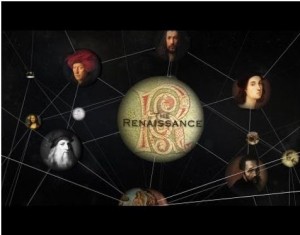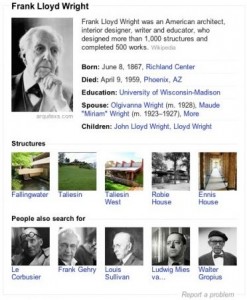
You might think that the web giant, Google, might be content with where it stands today; being the renowned Android operating system provider, the social network developer with G+, yet its announcement yesterday proved that their prime goal is to keep on improving their search engine.
Google rolled out a new feature that they call the Knowledge Graph; it’s basically a new tool meant to enhance search results by displaying a small box to the right of the page when entering a keyword of a popular or well-known person, place or thing.
What will you be seeing in this small box you ask yourself? Well, a short description, image, list of facts, location map as well as links to similar searches.

For instance, till now, if we’ve entered “Frank Lloyd Wright” as keywords for our search, we’d receive a list of websites and the first link might be to Wikipedia. But starting in the next couple of days, we’ll start viewing something similar to that of Wikipedia or other sourced information on the right side of the page, including a short summary of who Wright was, his birth date, etc. You’ll also get related searches. If Wright were still living and a Google+ user, you’d also get his Google+ profile link.
The new feature debuting Wednesday draws from a Google-built database of more than 500 million people, places and commonly requested things to provide a summary of vital information alongside the main search results.
Google Inc. spent the past two years poring through online encyclopedia Wikipedia, the CIA Factbook and other sources to expand a database of 12 million items that it picked up as part of its 2010 acquisition of Metaweb.
“The knowledge graph has been constructed using a lot of reliable sources of information, including the World CIA Fact Book, Wikipedia, etc. We also collect content of our own, like Google Books,” Shashidhar Thakur, Google’s Tech Lead in Search, told ABC News.
Google says you’ll start actually viewing the Knowledge Graph box as often as you see Google Maps, making it its largest search launch ever. It says it has surpassed the launch of Google Image and Google News in terms of the data available on its first day. Obviously, the database will continue to grow.
Well, it appears that this latest bit of technology comes in the midst of a competition hype in the tiresome race to build the supreme search engine. Starting with Bing, the Microsoft powered search engine, launching a “social sidebar” that integrates relevant information from friends on Facebook and Twitter. Apple is also a part of this hype with its adoption of Wolfram Alpha, the “computational search engine” that uses structured data sets, in an attempt to help power Siri ( its voice-activated digital assistant on the iPhone 4S).
This new enhancement might spare us a lot of time as well as remove some irrelevant websites, whose developers may have learnt to manipulate commonly requested search terms in order to appear more frequently on the first page of Google’s results. Google has repeatedly tried to remove such impertinent results with its ranking system, yet the developers seem to outsmart them by still using it to their favor in a way or another.
Another perk that might ultimately benefit Google from this Knowledge Graph if it proves to work as it is supposed to, is that it will give visitors less and less reasons to leave its website, and perhaps entering more search requests. Hence, earning them more revenue since it reaps the highest profit margins from commercial links that are clicked on its very own website.
This move might not resonate well among people; since it might be viewed as a sole promotion move of its own services rather than pointing visitors to other helpful Internet destinations.
Amit Singhal, a Google software engineer, doesn’t see it that way :
“As we answer more of our users’ questions, we save them time,” he said. “Time is the only quantity that we can’t make more of. When people save time, people search more. The Web gets more traffic and all boats rise.”
Well, we shall see how beneficial this will actually turn out, till then here’s the video provided via Google’s Blog:
![]()

Looking for a simple, elegant backup solution?
Genie Timeline 2012 is a new version of the number one continuous data protection program Timeline 2.1. It offers the first metro style user interface; enhanced performance, and added features. Like us on Facebook and Follow us on Twitter for the latest news.
>Follow @Genie9backup
![]()

